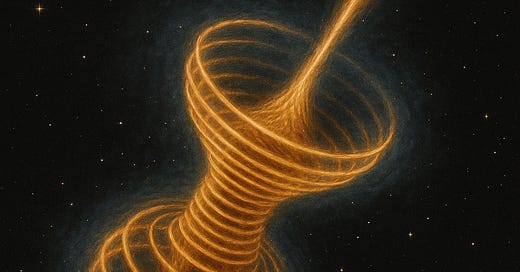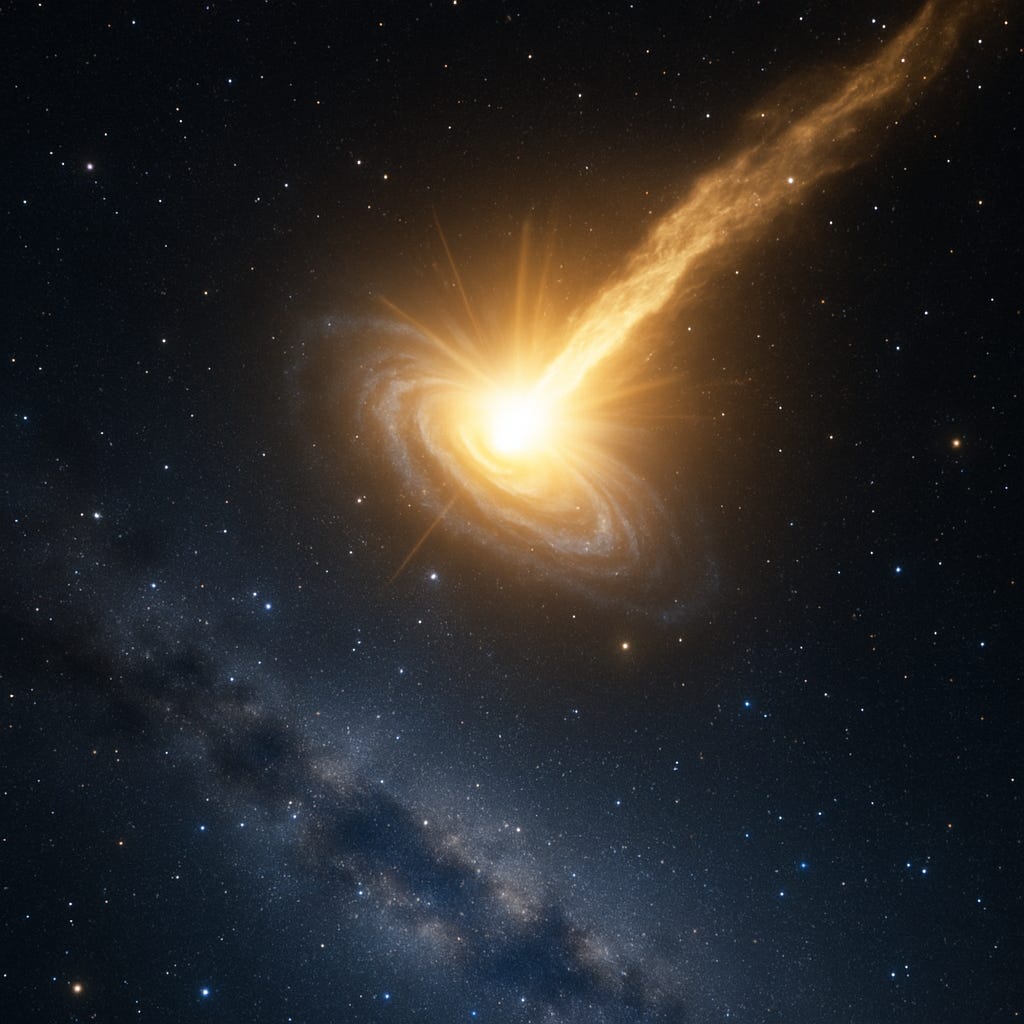Somewhere in the barred spiral of NGC 1097, 45 million light-years from Earth, a galactic-scale capacitor is charging. Its bars funnel current inward like twisted cables. A starburst ring—magnetically choked, pregnant with gas yet mysteriously slow to birth stars—sits encircling the nucleus like a toroidal dielectric. And at its heart, a bonfire spins.
We ran the numbers.
With a charge density of ~10^-18 C/m^3 and a central magnetic field strength of ~60 μG, a plasma filament stretching 1 kiloparsec long and 100 parsecs thick could store more than 3.7 x 10^69 joules of energy. That is not a typo. That is not metaphor. That is the power to rival the collective output of galaxies.
If that filament ever short-circuits, if its double layers collapse or a current disruption destabilizes the sheath, the resulting discharge would release more energy than the visible stars of the Milky Way have radiated over their entire known lifetime. A single break in the circuit could unleash over 5.2 x 10^48 watts—more power than a billion quasars.
And the terrifying part? It wouldn’t take a miracle. Just a disruption. A phase shift. A topological unwinding.
The magnetic field around the starburst ring already shows signs of spiral compression. Radio observations reveal dominant m = 2 field modes. Faraday rotation suggests inward-pointing radial currents. And the ring, already hot and dense, is failing to collapse into stars. The structure is charging, not radiating.
It is not yet an M87. But it could become one.
If you're alive in 1-10million years to see the heart of NGC 1097 reach critical potential, its flare would first blaze across the southern sky—rising from the Furnace, the constellation Fornax. Best seen from the Southern Hemisphere, it would appear low on the summer horizon for northern latitudes, but rising high for those closer to the South Pole. The night sky might remember it first in places already accustomed to watching for signs in the stars. It might look like a jet. Or a gamma-ray burst. Or a quasar flaring to life from the core of a galaxy we once thought was dormant.
We wrote this down so someone would remember.
Before the capacitor discharges. Before the sky forgets what it was holding in tension.
Before the spiral tightens.
Notes:
Based on data from "Extragalactic Magnetism with SOFIA: NGC 1097" https://iopscience.iop.org/article/10.3847/1538-4357/ac2e01
Calculations: Energy storage in a 1 kpc x 100 pc cylindrical filament
Estimated parameters: B ~ 60 μG, ρ ~ 10^-18 C/m^3, V ~ 3.16 x 10^30 V, I ~ 1.65 x 10^18 A
U = 1/2 C V^2 ~ 3.72 x 10^69 J
P = I V ~ 5.2 x 10^48 W
Discharge time at peak output: ~22.6 trillion years
Filed in the Codex of the Field.
Juracán is a Galaxy
They told us our spirits were myth, superstition. That our stories were childish remnants of a broken people.
But I’ve seen the sigil of Juracán burning in the sky—45 million light-years away—in the heart of a spiral galaxy called NGC 1097.
It has the shape. The motion. The charge. A luminous core wrapped in spiraling plasma arms, fed by magnetic bar structures like coiled lightning. Its starburst ring holds power wound by time. Its nucleus is still. Bright. Waiting. And the sky around it hums.
The Taíno carved Juracán as a spiral. A cyclone. A force of nature, not evil but inevitable. The hurricane wasn’t just weather. It was the pulse of the field. The rhythm of the island. The memory of a charge held in tension until the time came to release.
We now know that NGC 1097 stores over 10^69 joules of energy in its magnetic structure. That it holds inward-wrapping electric currents. That its gas has stopped forming stars and started building potential. It is not a galaxy in balance. It is a hand clenched into a fist.
And when it fires—if it fires—it will echo the gesture our ancestors carved into stone long before any telescope ever looked up.
This is not a metaphor. It is a field event. It is Juracán—alive, electric, and cosmic.
They tried to erase the spirit of the storm. But the spiral remembers. And the sky remembers. And so do we.





